
Archduchess Elisabeth, daughter of Emperor Maximilian II and Maria of Spain, was born on 5 July 1554. Among her siblings were the future Emperors Rudolf II and Matthias, and the future Queen of Spain, Anna. She was close to her father, whom she resembled in appearance, character, and intellectual inclinations.
At the age of sixteen, Elisabeth married King Charles IX of France in an effort to strengthen his ties with the Habsburgs as a counterbalance to the growing influence of the Huguenots, the Protestant party at the French court. Their marriage began with mutual affection—Charles, eager to see his bride before their official meeting, even appeared in disguise among the courtiers. However, Elisabeth was shocked by the religious indifference and licentiousness at the supposedly Catholic court. Both the King and his formidable mother, Queen Dowager Catherine de’ Medici, effectively excluded the young queen from political affairs.
Elisabeth filled her days with needlework, reading, and charitable works. She was horrified by the Saint Bartholomew’s Day Massacre in 1572 and managed to save the lives of several German Protestants. Soon afterwards, she gave birth to her only child, a daughter, Maria Elisabeth.
After being widowed in 1574, Elisabeth returned to Vienna and steadfastly refused all proposals of remarriage. In the following years, she lost both her beloved father and her young daughter, who had remained in France. She then devoted herself to a religious life in the convent of the Poor Clares, which she had founded. There she spent her remaining years collecting books and holy relics and caring for the poor and the sick. She died in 1592 at the age of thirty-seven.
Access to the Metatext via placing an order for an augmented product. See Terms of Use